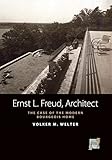Ernst L. Freud, Architect : The Case of the Modern Bourgeois Home / Volker M. Welter.
Material type: TextSeries: Space and Place ; 5Publisher: New York ; Oxford : Berghahn Books, [2011]Copyright date: ©2011Description: 1 online resource (230 p.)Content type:
TextSeries: Space and Place ; 5Publisher: New York ; Oxford : Berghahn Books, [2011]Copyright date: ©2011Description: 1 online resource (230 p.)Content type: - 9780857452337
- 9780857452344
- 720.92
- NA997.F74 W45 2012
- online - DeGruyter
| Item type | Current library | Call number | URL | Status | Notes | Barcode | |
|---|---|---|---|---|---|---|---|
 eBook
eBook
|
Biblioteca "Angelicum" Pont. Univ. S.Tommaso d'Aquino Nuvola online | online - DeGruyter (Browse shelf(Opens below)) | Online access | Not for loan (Accesso limitato) | Accesso per gli utenti autorizzati / Access for authorized users | (dgr)9780857452344 |
Frontmatter -- CONTENTS -- List of Illustrations -- List of Tables -- Acknowledgments -- Introduction -- Chapter 1 Modern Bourgeois Domestic Architecture of the Weimar Republic -- Chapter 2 The Making of an Architect -- Chapter 3 Going Modern with Rainer Maria Rilke and Adolf Loos -- Chapter 4 Society Architect in Berlin -- Chapter 5 Houses in and around Berlin -- Chapter 6 Couches, Consulting Rooms, and Clinics -- Chapter 7 At Home in England -- Chapter 8 Family Architect -- Chapter 9 Architecture without Quality? -- Selected List of Works -- Selected Bibliography -- Index
restricted access online access with authorization star
http://purl.org/coar/access_right/c_16ec
Ernst L. Freud (1892–1970) was a son of Sigmund Freud and the father of painter Lucian Freud and the late Sir Clement Freud, politician and broadcaster. After his studies in Munich and Vienna, where he and his friend Richard Neutra attended Adolf Loos’s private Bauschule, Freud practiced in Berlin and, after 1933, in London. Even though his work focused on domestic architecture and interiors, Freud was possibly the first architect to design psychoanalytical consulting rooms—including the customary couches—a subject dealt with here for the first time. By interweaving an account of Freud’s professional and personal life in Vienna, Berlin, and London with a critical discussion of selected examples of his domestic architecture, interior designs, and psychoanalytic consulting rooms, the author offers a rich tapestry of Ernst L. Freud’s world. His clients constituted a “Who’s Who” of the Jewish and non-Jewish bourgeoisie in 1920s Berlin and later in London, among them the S. Fischer publisher family, Melanie Klein, Ernest Jones, the Spenders, and Julian Huxley. While moving within a social class known for its cultural and avant-garde activities, Freud refrained from spatial, formal, or technological experiments. Instead, he focused on creating modern homes for his bourgeois clients.
Mode of access: Internet via World Wide Web.
In English.
Description based on online resource; title from PDF title page (publisher's Web site, viewed 25. Jun 2024)


